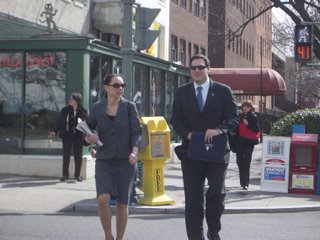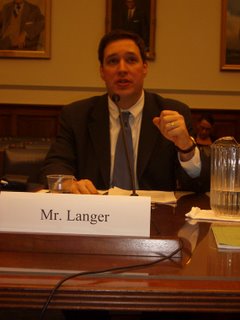Yes, I’d promised to say something about the Fieldston assembly controversy, and now one of the Liberty Blog’s readers has reminded me that I’d made that promise. For me, it’s been a matter of letting my thoughts on the matter coalesce a bit. It’s easy for me to jot down a few paragraphs on the justice of a former employer vindictively suing their employee when they’ve made a king’s ransom off of him, or to talk about some property rights issue that’s been near and dear to my heart.
But when it comes to some slightly more obscure issues, I’ve got to think about it a little more. Such it is with the Fieldston issue, which has a lot of different aspects to it. I’ve actually asked some of my friends, non-Fieldston friends, for their takes on it, given the New York Times article, as a way of having a sounding board.
Anyhow, I got an e-mail a few weeks back, letting me know about the controversy. Then I pulled up the article in the Times, and read through it some more. Essentially, here’s the situation, as reported:
http://tinyurl.com/qfhwmShelving of Panel on Mideast Roils School February 17, 2006
When the principal of the elite Fieldston school notified parents by e-mail of an assembly that was to feature two Palestinian speakers, he said that it would further the school's "progressive reputation" and that the Palestinian viewpoint was one that "few of us, students or faculty, are familiar with or can claim to understand."
Then came a flurry of e-mail messages and telephone calls from parents who objected to one of the speakers, who has advocated a boycott of
Israel, as well as the fact that no Israelis were on the panel. On Tuesday, the high school's principal, John Love, sent another e-mail message canceling the event and explaining that the forum was "not appropriate given the sensitivity and complexity of the issue."
…
The controversy started on Friday, when Dr. Love, principal of the Fieldston Upper School — the 9th- through 12th-grade component of the Ethical Culture Fieldston School — sent an e-mail message to parents about the assembly, planned for next Thursday. He said it would feature two 10-minute speeches followed by questions.
Muhammad Muslih, a Long Island University professor, would speak in favor of a "two-state solution" to the Israeli-Palestinian conflict, he wrote, while Mazin Qumsiyeh, identified as an associate professor at Yale, would speak in favor of a "one-state solution." (A two-state solution envisions Israeli and Palestinian states side-by-side; a one-state solution envisions a single state in which Jews and Palestinians live together, and there is no longer a country of Israel.)
The Israeli perspective, Dr. Love wrote, would be the subject of a future assembly. But in a school with a substantial Jewish population, that did not sit right. Then Zach Tumin, a parent, sent an e-mail message to other parents, describing Dr. Qumsiyeh as an "unfortunate choice."
He included portions of an Anti-Defamation League press release describing Dr. Qumsiyeh as an "extremist anti-Israel activist." The release was issued amid a controversy last month, in which the World Economic Forum published, then apologized for, a magazine with an article in which Dr. Qumsiyeh called for a boycott of Israel and compared Israel's policies toward Palestinians to apartheid.
In canceling the assembly, Dr. Love wrote to parents that he had received "many thoughtful phone calls and e-mails." "Many of you who were most concerned about our plan framed your concerns in the most positive and constructive terms, and I deeply regret the unhappiness that my letter and support for this project has caused you," he wrote.
That note, however, generated even more unhappiness. "It may not have been the best planned event, but the symbolism of canceling it is terrible," said Kenneth Roth, a Fieldston parent who is executive director of Human Rights Watch but said he was speaking privately. "It suggests that some parents who supposedly believe in progressive education and trust their kids to hear all sides of disputes don't extend that principle to disputes about Israel."
Renée Berliner Rush, a parent who opposed the assembly, was irate at the way in which it was canceled, saying school officials should have apologized for planning a one-sided forum in the first place.
"It basically blamed a group of parents, which is not a reason to cancel an assembly," she said.
"This wasn't about Palestinians. This was about equality and bigotry and a fair, open forum."
…At an assembly on gender roles held yesterday, and in yet another e-mail message to parents, Dr. Love announced that a special "modified awareness day" about the Middle East would take place in the spring. The longer format, he wrote, would enable "the widest possible perspective on this complex issue."
Ms. Curwen, the school spokeswoman, explained: "This is a volatile and complicated topic for the world, let alone for a school. And we decided it deserved more than a 40-minute assembly."
----end quoted material---
I’m of a lot of minds on this, and it’s gotten a host of different reactions from people I’ve talked to. Someone thought it was more than a bit pretentious for a high school to take itself and its dedication to issues so seriously. Perhaps, but then, Fieldston isn’t a normal high school in that regard, and has always prided itself on such a dedication.
I'll say at the outset that I am ardently pro-Israel. Yes, I am jewish, but religious affinities aside, I also believe that Israel has a right to exist, has been a tremendous friend and ally of the United States, and as a free nation in the Middle East, must be supported and protected by this nation.
That's not to say that Israel is perfect and hasn't made mistakes in the course of its history. But given its reason for being and the overwhelming threats it faces on all sides, when compared to the nations that surround it Israel compares favorably.
But on to the issue at hand. First and foremost, I have to agree with the initial unhappiness with the program as proposed. All too often in the media, for instance, we see a viewpoint presented, and then the reporters have to find that one person with the most extreme opposing viewpoint, and it gets presented as a balanced debate. In this instance, we have two people with divergent viewpoints essentially coming from the same perspective and reaching similar conclusions. But for those in the audience unsophisticated or uninformed as to the pro-Israel viewpoint (and yes, there are a range of viewpoints within that set, too), they would be left with a view of the subject that was missing some pretty important elements.
Then again, Fieldston has always prided itself on challenging dogmas (as long as the challenge comes from a “progressive” viewpoint, of course). Philosophically, they want students to continue thinking critically about things, and be moved to the edges of their comfort zones—and Friday assemblies (do they still do them on Fridays, I wonder?) were one way that they would do that.
Yes, when I was in school at Fieldston, just about every Friday was an assembly, just after, what 2nd period? 3rd period? Each advisory (or “homeroom”) would have it’s own seats, and we’d go there. When I was luckily put in Mal Goodman’s advisory my junior year, I was with such a good group of people that we’d usually whisper among ourselves when something in an assembly sparked a comment – I’d say something to David, David would offer it to Sam, who’d offer it to Gideon, who’d offer it to Larry, etc, etc, etc. Like during Senior year, when someone we all knew came back from her freshman year in college to do an assembly on world hunger.
She mentioned something about being able to feed people, if only we’d shut down the US military for two weeks! David, who can sometimes be more hawkish than I think he’d like to admit, and I looked at each other and passed along a few choice comments about that (understand, this was before the Berlin Wall fell and the Soviet Union was still very much an ominous enemy to the East).
What’s interesting about Fieldston students is their response to such things – and I guess here is where Fieldston might have missed the boat. Yes, Fieldston should have offered a pro-Israel perspective in their assembly. And yes, they are probably right that the issue is much too complex to be solved within a 40 minute assembly program – or even adequately considered. So a longer half-day program might be more appropriate (and I say, “might” – after all, are there other issues that are important to other people at Fieldston that those people might want to spend half-days having the school discuss?).
But the administration can’t be so cavalier about canceling the event and then be surprised at the response. They can’t have it both ways – you want your students to be critical, then you should expect the following:
That if your students think that a program is less-than-scholarly, that they’re going to say something;
That if you respond to less than their satisfaction; they’re going to say something;
What’s more, they’re going to do so in a myriad of ways, and do it prominently.
It’s like the time we had an assembly with a band. The band invited students to dance on the stage and in the aisles. A few authority figures took exception to this, and began to re-seat those students who were dancing. Then, when the assembly was over, one of the students who had been re-seated took the opportunity to walk up to the mike on stage, to thank the band for coming, and to thank the administrators for their fascism.
He was suspended for that, which then prompted a number of students to put up posters denouncing the police state (I still applaud you for your quick thinking and quick wit, JB).
So those are my thoughts. Yes, they’re all over the place. But then again, I’m a Fieldston alumnus, and was educated to see a variety of sides to an issue.
- Andrew Langer












